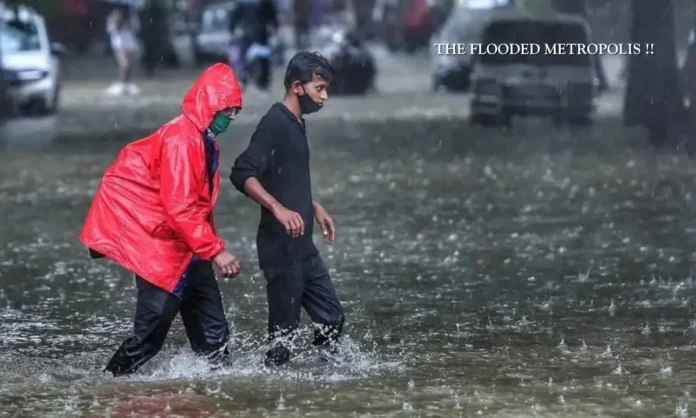Summary
- Schools and Colleges Closed: Due to relentless rainfall and a red alert issued by IMD, educational institutions in Mumbai were shut on August 19, 2025.
- Local Train Services Delayed: Heavy rainfall caused delays in local trains, with traffic jams and waterlogging disrupting daily life.
- Vikhroli Records Highest Rainfall: Vikhroli suburb recorded a staggering 194.5 mm of rain in just 21 hours, exacerbating the city’s flooding situation.
The Current Crisis in Mumbai Floods August 2025
Mumbai is facing a citywide crisis due to the Mumbai Floods August 2025, with incessant rains causing severe disruption. On August 19, 2025, low-lying areas such as Borivali, Andheri, Sion, and Chembur experienced waterlogging that disrupted daily routines, including office commutes and school attendance. The India Meteorological Department (IMD) issued a red alert, forecasting extremely heavy showers, prompting immediate action by local authorities. This extreme weather event follows a series of intense rains that have severely impacted the city, bringing daily life to a halt.
In response, schools and colleges were shut due to the ongoing rains. Several critical roads were submerged, and local train services were delayed for hours, further straining the city’s transportation infrastructure. The Mumbai Floods August 2025 serve as a reminder of the city’s vulnerability to such extreme weather events, and the urgent need for better flood management and infrastructure to address the rising challenges posed by climate change.
Analyzing the Situation Severe Disruptions Across Mumbai
The Mumbai Floods August 2025 have caused widespread disruption across the city, with the red alert issued by the IMD emphasizing the seriousness of the situation. The rains began on August 18 and continued into August 19, with the heaviest downpours recorded during the early morning hours. Vikhroli, a suburb in the eastern part of Mumbai, recorded 194.5 mm of rainfall in just 21 hours, the highest in the city. In response, the Brihanmumbai Municipal Corporation (BMC) initiated flood control measures, but traffic jams and waterlogging were unavoidable. Several key areas, including Gandhi Market and Malabar Hill, were submerged, resulting in significant disruptions to daily life.
Local train services, which are vital to Mumbai’s transportation system, were delayed by several hours as water levels rose on tracks, and debris from floodwaters blocked important lines. The Mumbai Floods August 2025 caused a ripple effect, impacting businesses, schools, and essential services across the city.
Root Causes – Why Is Mumbai Flooding?
While the immediate focus has been on the rainfall and its effects, a deeper dive into the issue reveals the underlying challenges contributing to the city’s vulnerability. The rapid urbanization of Mumbai in recent decades, combined with inadequate drainage systems, has worsened flooding. Many low-lying areas in the city lack proper flood management systems, making them prone to inundation during heavy rains.
Additionally, climate change has altered rainfall patterns in the region, leading to more frequent instances of extremely heavy showers. The government has already announced plans to upgrade Mumbai’s stormwater drainage network, but these measures will take time and are unlikely to provide immediate relief, as flooding is caused by both weather and infrastructural inefficiencies.
Critical Evaluation – What Needs to Change?
The Mumbai Floods August 2025 highlight the gaps in the city’s flood management systems. Despite numerous warnings about the city’s vulnerability, Mumbai’s infrastructure has failed to cope with such extreme events. The government has implemented short-term measures like flood barriers and pumps, but the long-term solution lies in improving urban planning and creating more sustainable drainage systems. Experts also suggest focusing on green spaces and reforestation in flood-prone areas to help absorb excess water.
The slow government response has drawn criticism, especially since local train services were delayed for hours without prior warnings. Although schools and colleges were closed as a precaution, public transport remained overloaded, highlighting the lack of contingency planning for emergencies. Mumbai’s future will depend on its ability to adapt to changing weather patterns and address the infrastructural gaps that continue to hinder the city’s resilience to floods.
Looking Forward – What’s the Future of Mumbai’s Flood Management?
Looking ahead, the Mumbai Floods August 2025 may become a recurring issue as the city faces more extreme weather events. Climate models predict more intense rainfall patterns, and Mumbai must accelerate its flood management initiatives. This includes investing in smart drainage solutions, expanding green infrastructure, and updating flood-risk mapping to ensure more accurate and timely warnings.
It is also crucial for the local government to adopt an integrated approach to urban planning that incorporates climate risks. The recent floods are a stark reminder of how climate change is impacting even the most resilient cities, and Mumbai must prepare for similar events in the future. Strengthening the city’s infrastructure and public transport systems will be vital in mitigating the impact of future floods.
Final Thoughts: Mumbai Floods August 2025
The Mumbai Floods August 2025 have revealed the city’s vulnerability to extreme weather events and the urgent need for improved flood management. The combination of heavy rainfall, inadequate infrastructure, and rapid urbanization has left Mumbai struggling to cope with the aftermath. The closure of schools, delays in local train services, and waterlogging on key roads are just a few immediate consequences of this ongoing crisis.
In response, Mumbai’s administration has begun implementing flood control measures, but these need to be expanded and improved. The city must now focus on long-term solutions, such as better drainage systems and climate-resilient urban planning, to avoid similar crises in the future. As the Mumbai Floods August 2025 demonstrate, the challenges of climate change are here to stay, and cities around the world, especially those like Mumbai, must adapt to an uncertain, waterlogged future.


